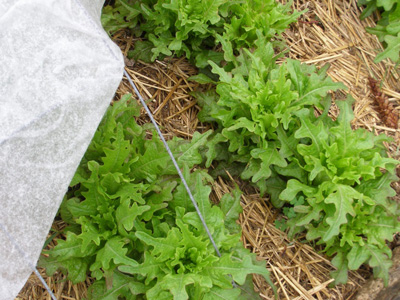Smart gardening for insects – cover up the rows!
Using row covers to prevent insect damage is a smart gardening practice.

By using row covers properly, vegetable gardeners can reduce or eliminate the need for pesticides on certain crops. Row covers are exactly that, a material designed to cover rows. Of course, not all row covers are created equal, so it’s important for gardeners to know what the options are, what each type provides and determine their own goals for their vegetable garden. If a gardener doesn’t have traditional rows, they can adjust a cover to fit their square foot garden, raised bed or planting area.
Pick a row cover that fits your goals
Row covers come in different forms, from perforated plastic to spunbonded polyester or polypropylene. Different weights are available and it’s the cover’s weight that determines how much light will be transmitted through, and ultimately, its best use in the garden.
Lightweight covers that are 0.5 to 0.6 ounces per square yard are primarily used for insect control. Due to their light weight, they transmit the most light – 85 to 90 percent. This material will easily tear, so it doesn’t have as long a life as heavier covers.
There are also mid-weight covers from 0.9 to 1.25 ounces per square yard, which are used to provide early maturity, increase early yields and total yields, improve quality and extend the season. They allow 70 percent of light through.
Heavy covers from 1.25 to 2 ounces per square yard are used mainly for frost protection as they only transmit 30 to 40 percent of light through.
How to cover up for insects
Install your lightweight row cover immediately after planting. Be sure to secure all edges to the ground with soil, rocks or metal pins. Making sure there are no entrance holes for pest insects to enter is critical to your prevention efforts.
You also want to make sure you are practicing crop rotation and not planting a vegetable of the same family in the same location for at least three years. Six years is even better if you have this option. Some of the insects overwinter at the edges of the garden, and the following spring they will move back to a vegetable’s location from the previous year. If you change the location of the vegetable and make use of a row cover, the insects aren’t as likely to find the vegetable they seek. Be conscious that when using row covers, if a pest does sneak in, no natural insect enemies such as ladybugs, lacewings and other predatory and parasitoid insects will be present under the covers to assist; it’s best to prevent the pest from getting in at the start.
The lightweight covers will not need a support over most vegetables. The only exceptions will be vegetables with tender growing points, such as tomatoes, peppers and summer squash. In windy conditions, a row cover may damage these plants from wind abrasion. Make use of hoops formed from wire, PVC or electrical conduit to support row covers for these vegetables.

Oak leaf lettuce under a lightweight cover. The gardener has used wire supports, which aren’t needed for this crop. Photo: mystuart, Flickr.com
What insects can you control by covering up?
By covering some vegetables right after spring planting, you will control a number of adult insects from finding the vegetables they seek. Cabbage root maggot flies, cabbageworms and cabbage loopers will attack all brassicas, such as broccoli, cabbage and cauliflower. Flea beetles that attack a variety of vegetables can be controlled as well by covering up brassicas, potatoes, tomatoes and eggplants as soon as you plant.
Cover your spinach, beets and chard to prevent spinach leafminer flies from laying eggs. You can control striped cucumber beetles from getting to your melons, summer squash, cucumbers, winter squash and pumpkins by covering up after planting; be sure to remove the cover when flowers appear as bees and other pollinators will need to get to the flowers to pollinate.
Row cover considerations
Be mindful that using row covers will take extra time, effort and continued investment. Michigan State University Extension advises gardeners to continue monitoring vegetables under row covers for too high of temperatures, which may cause blossom drop or reduce quality of cool season crops. Covers may be damaged if animals have access to them, and lightweight covers may only last one season, so disposal can be a concern. If you are looking for a smart gardening practice to reduce your need for pesticides, consider row covers as a tool within your smart gardening toolkit to assist with insect control.



 Print
Print Email
Email


